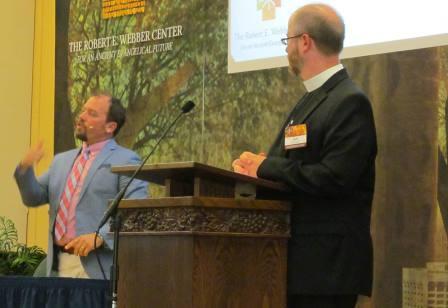
Discipleship, becoming Christ-like, empowered by the Spirit to image God to the world is not magic. Nor is it merely intellectual. It’s a matter of re-forming our loves, re-narrativing our identities, re-habituating our virtue. And that is centered in the practices of the people of God gathered by the Spirit around Christ’s Word and the table.
Love takes practice. Worship is our gymnasium. . . .
— Conclusion to James K.A. Smith’s presentation Liturgical Discipleship: Worship as the Center of Spiritual Formation at the 2014 Ancient Evangelical Future Conference (Theme: As We Worship, So We Believe: How Christian Worship Forms Christian Faith).
The 2014 Ancient Evangelical Future Conference, hosted by the Robert E. Webber Center at Trinity School for Ministry (Ambridge, PA), was a significant opportunity to
- wrestle with As We Worship, So We Believe: How Christian Worship Forms Christian Faith — personally and with respect to the various communities with which I am connected
- explore the development of A Theology for Higher Education for ESN
- expand/deepen the Emerging Scholars Network (and our budding partnerships)
- envision more of the framing of ESN’s Devotionals for/by Academics.
James K.A. Smith’s presentation on Liturgical Discipleship: Worship as the Center of Spiritual Formation (Youtube, ~ 1 hour) struck a deep chord and I am still giving it prayerful consideration. I encourage you to meditate upon it in preparation for the Lord’s Day. To God be the glory!
A few questions . . .

- What is at stake when we worship? What is the story which you have heard, dwelled in, shared? Does it “capture your imagination”, guide you on a gut level?
- Do you “feel” not only centripetally pulled into regular, intentional worship and the practice of spiritual disciplines, but also centrifugally sent forth as a “sanctified” culture-maker?
- How do you address the tension between “all of life as worship” with the value of the weekly formative gathering of the people of God around the Word and the table?
- Who are we as creatures? What is the nature of human beings? Do you concur that the “brain on the stick picture of the human person is a remarkably modernist way to think about human beings and yet in some ways North American Evangelical Protestantism took that hook-line-and-sinker without realizing that it was sort of foreign food”?
- Are you more a “lover” than a “thinking thing”? Are you primarily led by your desires?
- What are the habits, disciplines, cultural practices which form your love?
- What rival liturgies do you encounter on campus, in your neighborhood/home, when shopping, in the local congregation of which you are a member (!), and our culture? What counterformational measures are you engaged in so that you do not lose your true/primary love of God?
- Does form matter in worship? Agree/disagree with Smith? Why/why not? What do you think about his distinction between form (i.e., the narrative arc that the people of God are carried through when we are called to worship through to when we’re blessed, charged and sent forth from worship) and style?
- Do habits (and repitition) matter as part of worship? Is there “a virtue to going through the motions”? Agree/disagree with Smith? Why/why not?
- Does liturgical catechesis matter as part of worship? Agree/disagree with Smith? Why/why not?
- What are your thoughts on Smith’s “reading” of Augustine? Remember Confessions won ESN’s Best Christian Book of All Time 😉
“Thank-you!” to Joel Scandrett, Director of the Robert E. Webber Center, for his superb leadership of the conference. I look forward to attending next year’s 🙂 To God be the glory!
PS. In “The Sunday News”, I will share a report regarding encounters with several of Marc Baer’s Mere Believers when at Trinity School for Ministry. Don’t miss the story. . . .
William Wilberforce defined Christian as “a pilgrim travelling on business through a strange country.” — Marc Baer in Mere Believers: How Eight Faithful Lives Changed the Course of History (Wipf and Stock, 2013).
6/7/2014 (7:35 pm, 8:06 pm): Small edits/corrections, some additional reflections, and a picture of the session in order for better on-line sharing.
Tom enjoys daily conversations regarding living out the Biblical Story with his wife Theresa and their four girls, around the block, at Elizabethtown Brethren in Christ Church (where he teaches adult electives and co-leads a small group), among healthcare professionals as the Northeast Regional Director for the Christian Medical & Dental Associations (CMDA), and in higher ed as a volunteer with the Emerging Scholars Network (ESN). For a number of years, the Christian Medical Society / CMDA at Penn State College of Medicine was the hub of his ministry with CMDA. Note: Tom served with InterVarsity Christian Fellowship / USA for 20+ years, including 6+ years as the Associate Director of ESN. He has written for the ESN blog from its launch in August 2008. He has studied Biology (B.S.), Higher Education (M.A.), Spiritual Direction (Certificate), Spiritual Formation (M.A.R.), Ministry to Emerging Generations (D.Min.). To God be the glory!

Leave a Reply